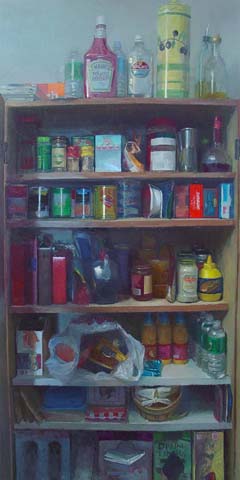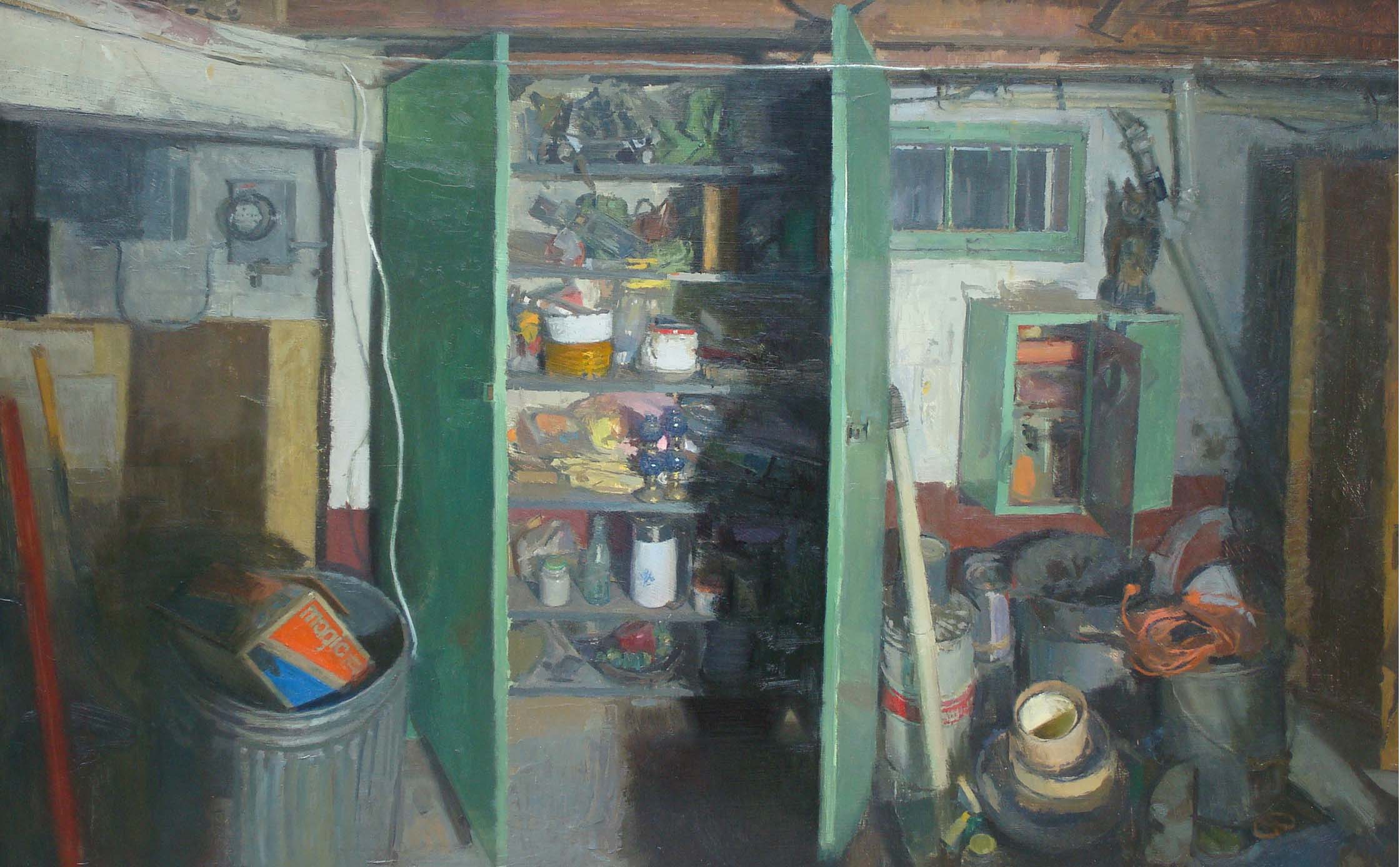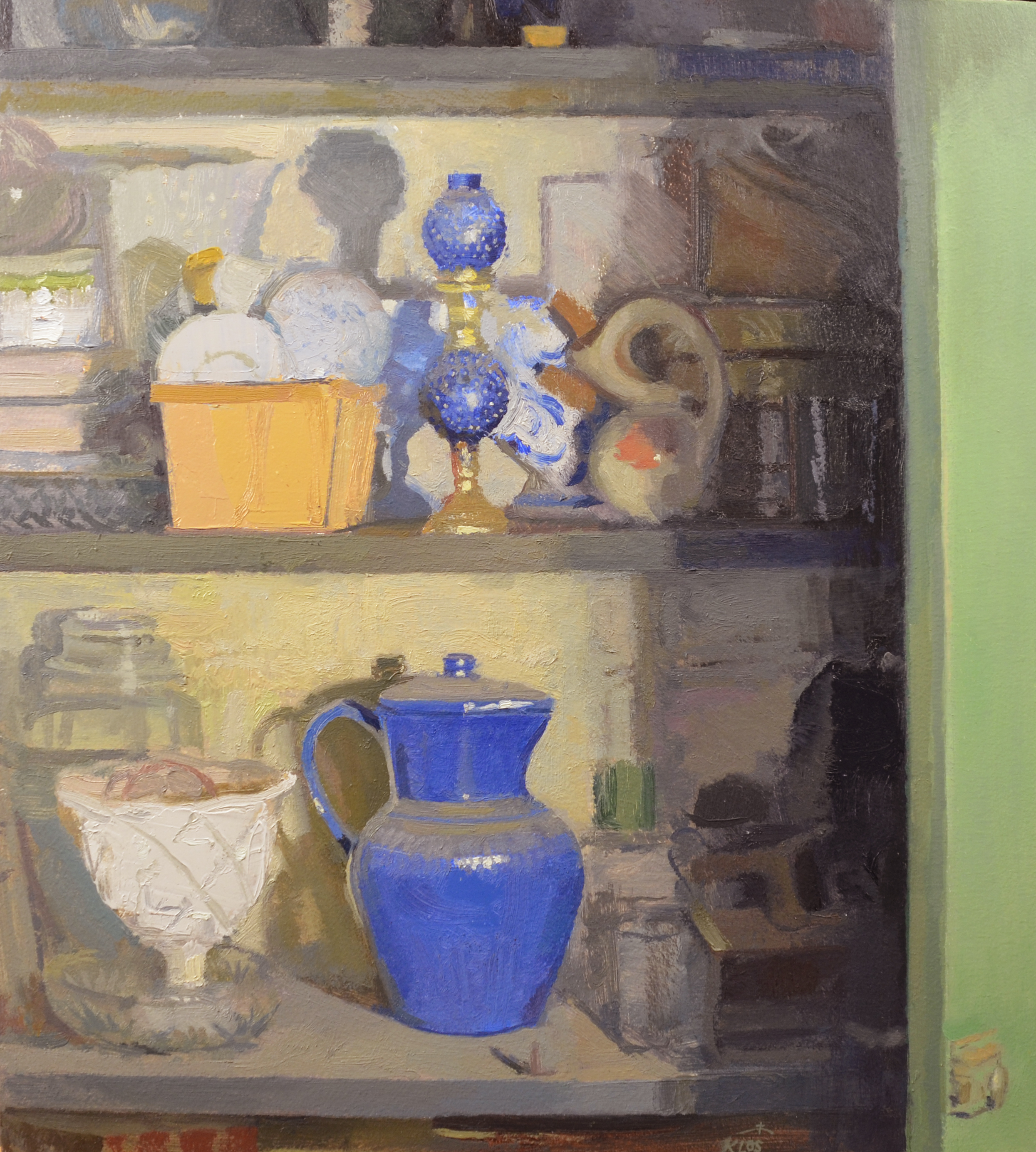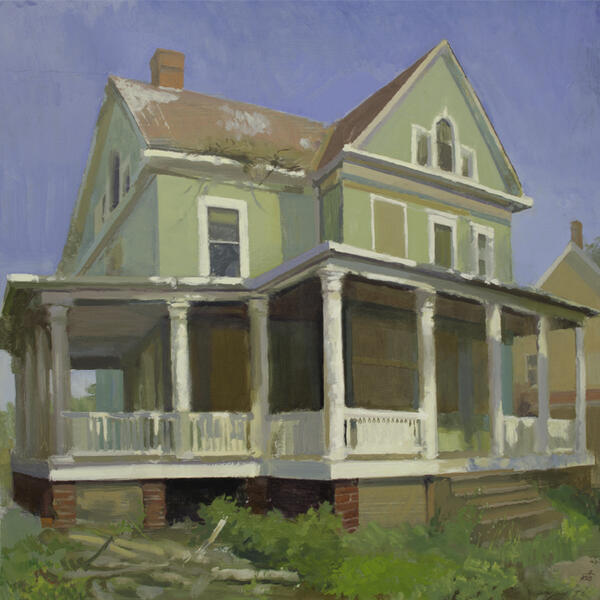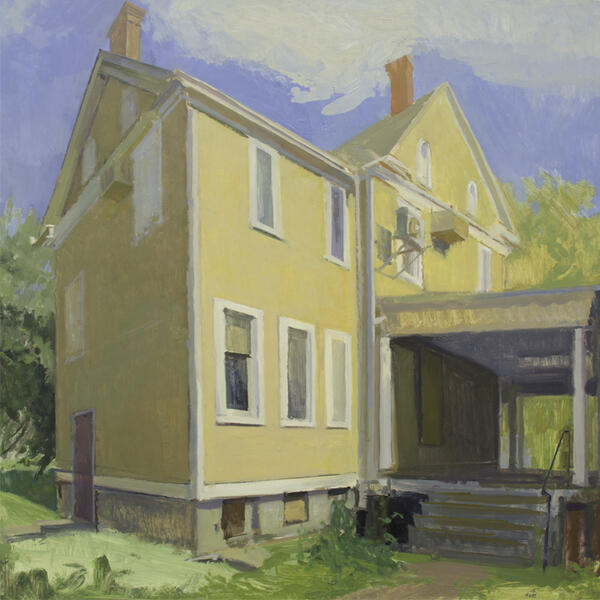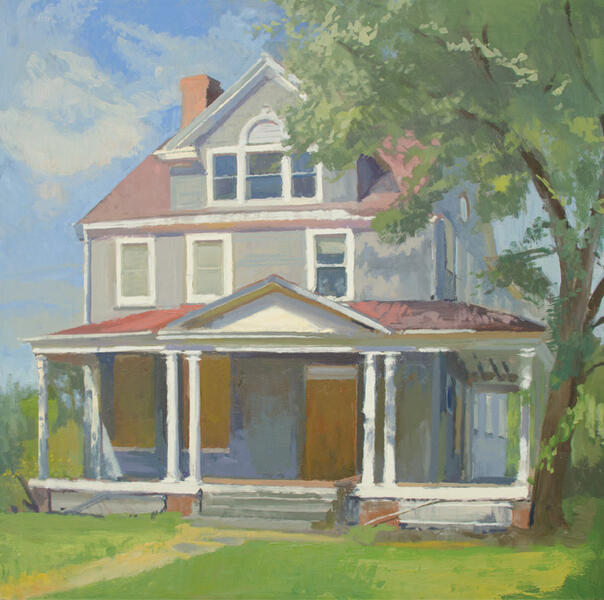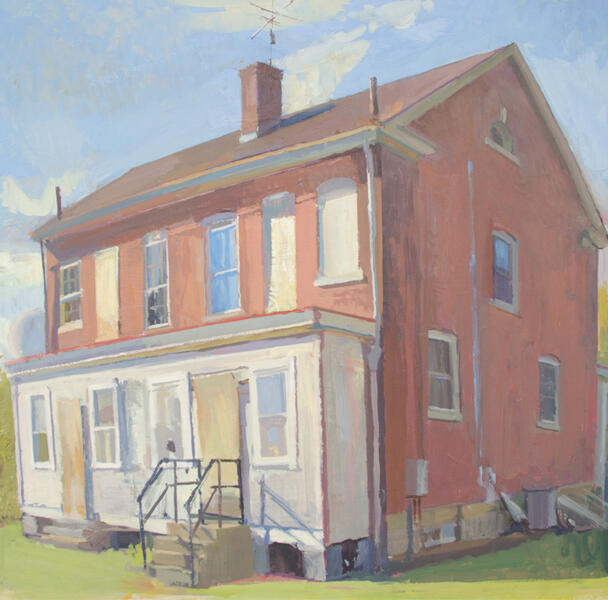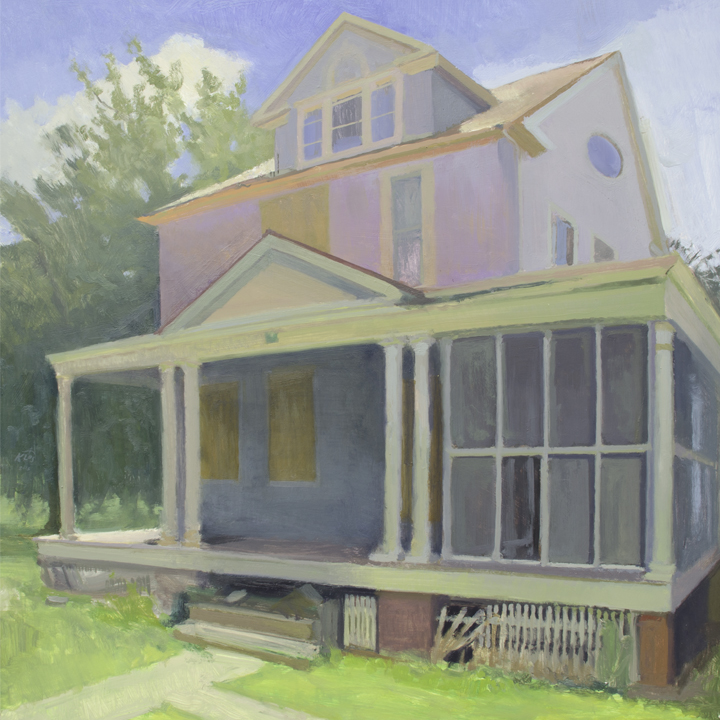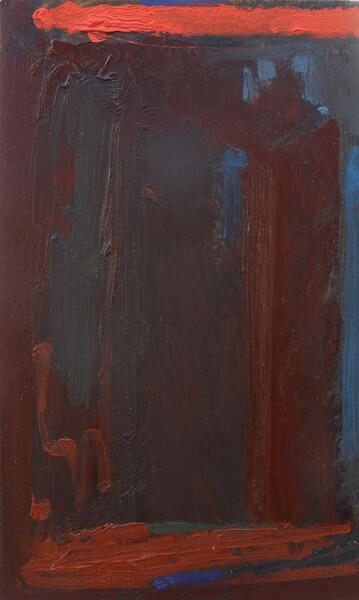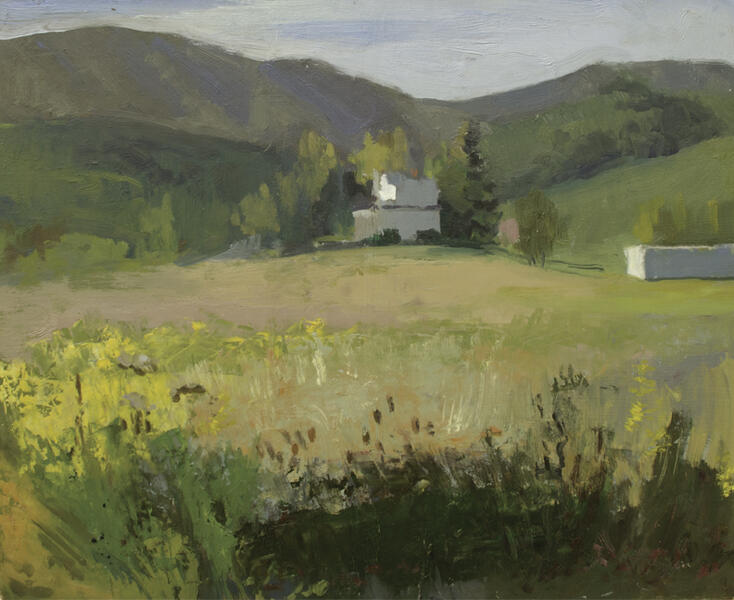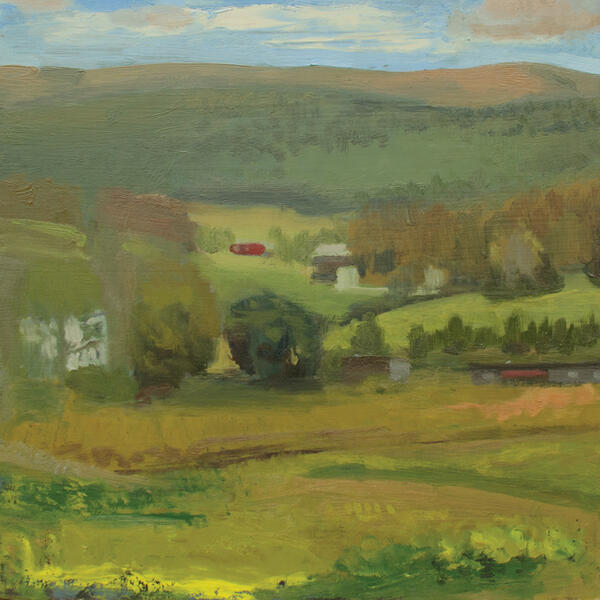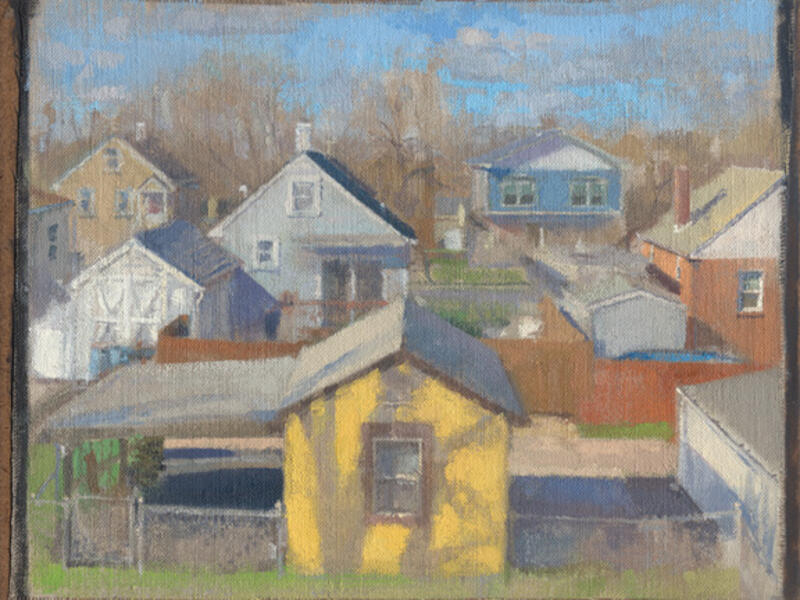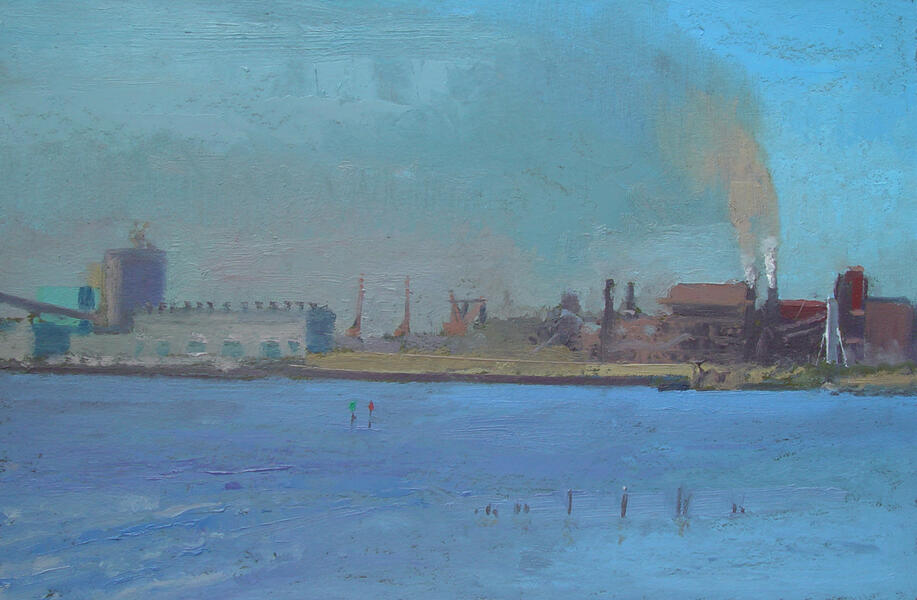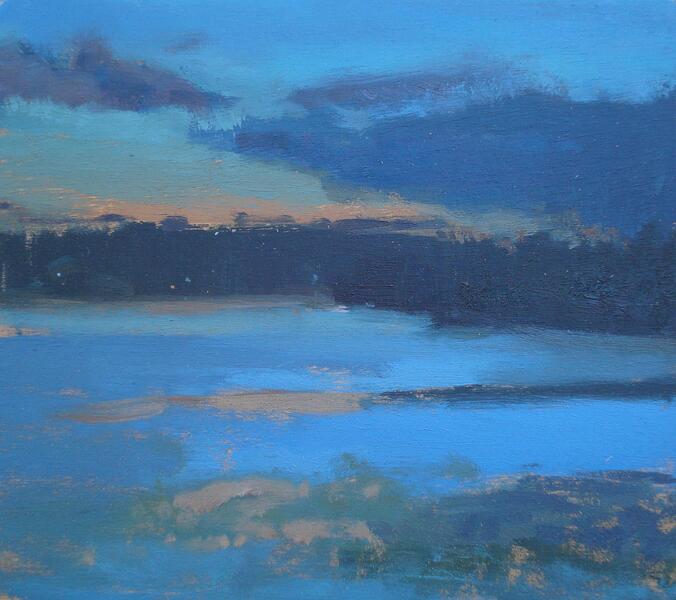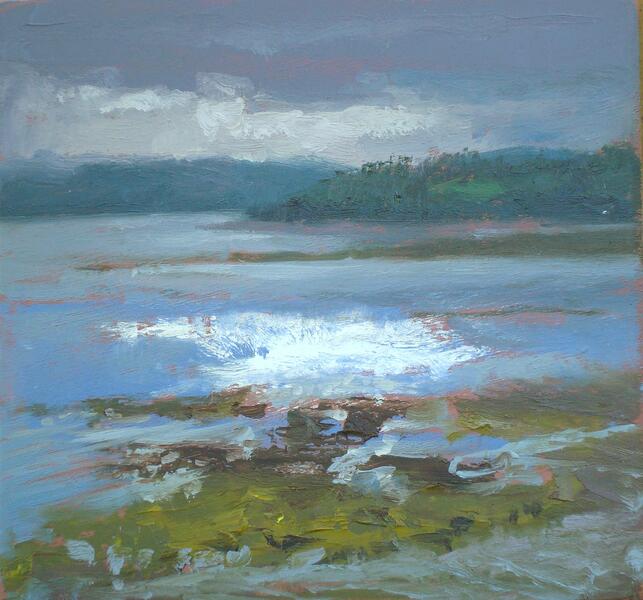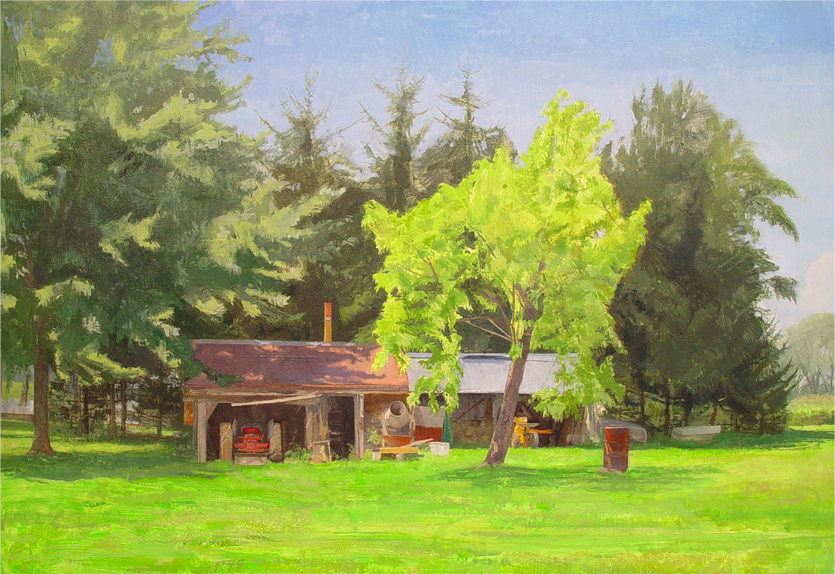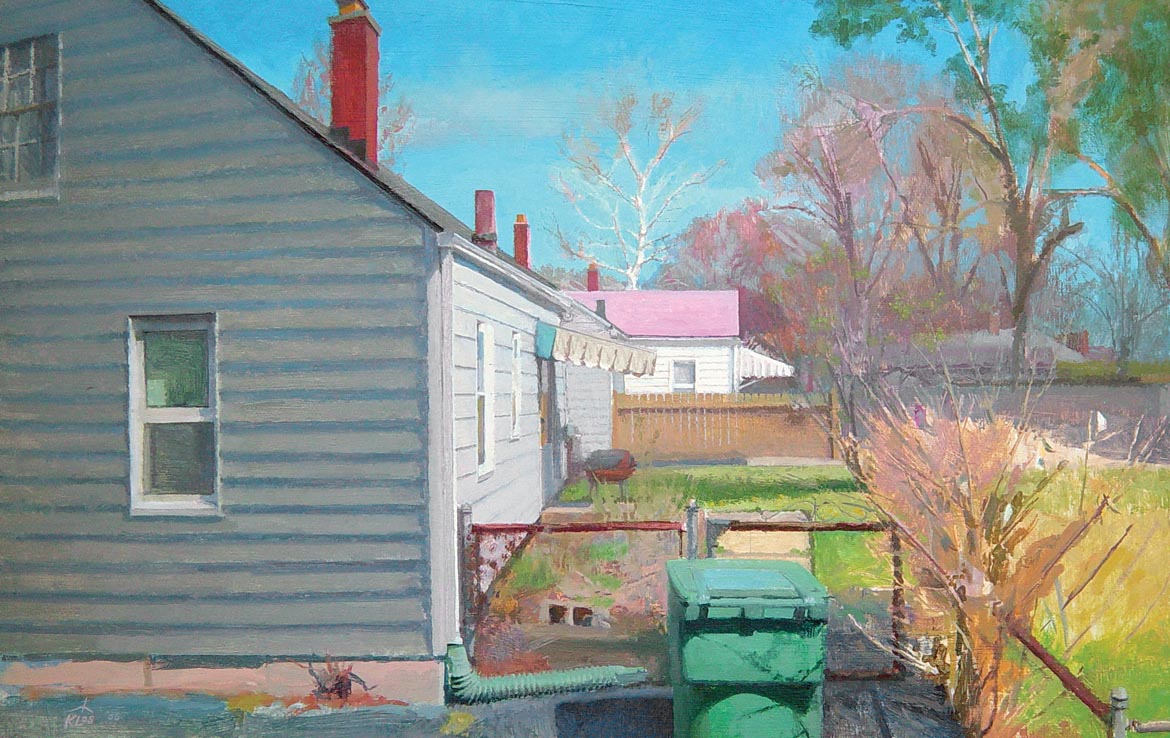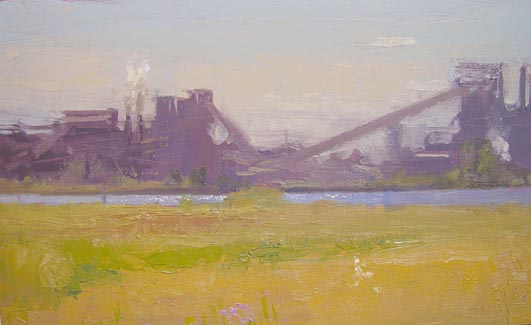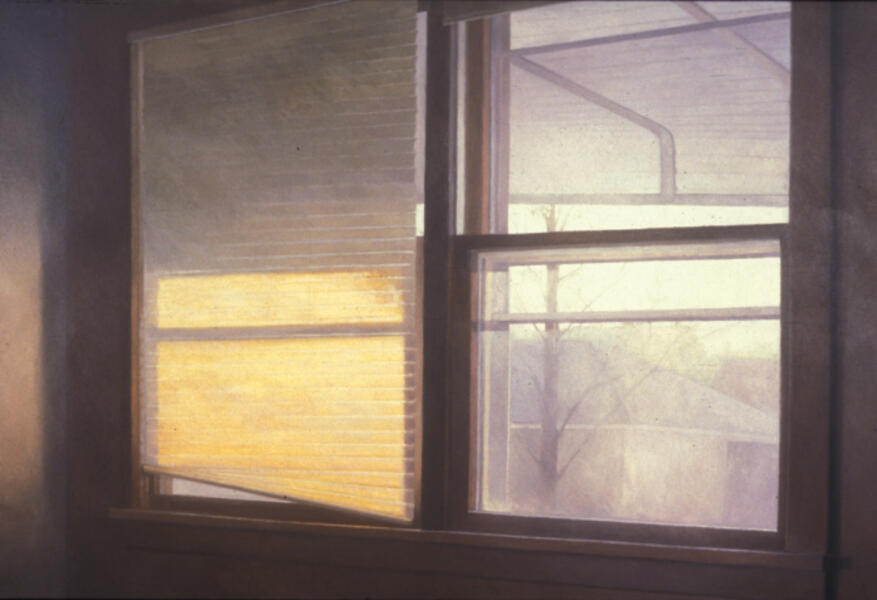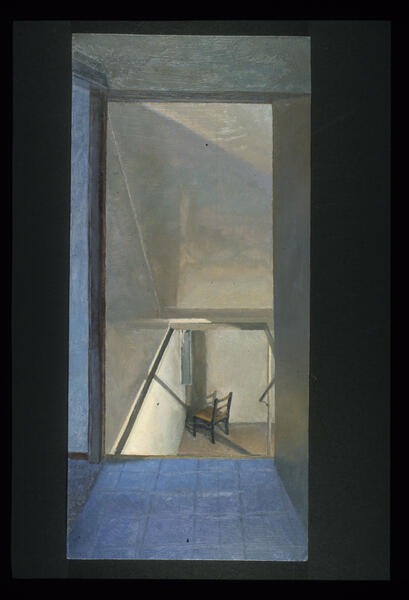Work samples
-
Klos, Walton, and White, 3 Perceptual Painters @ Gross McCleafThis video was made by John Thornton at my exhibition in October 2018.
About Matt
Baltimore County
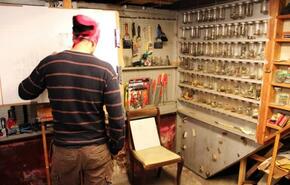
Matt Klos is a painter of interiors and plein-air landscapes. His works have been exhibited nationally and internationally and he was awarded Individual Artist Awards from the Maryland State Arts Council in both 2012 and 2008. Klos was awarded a five-week artist in residence award through MICA's Alfred and Trafford Klotz visiting artist program. His work was selected for a solo exhibition award at the Prince Street Gallery in Chelsea, NY in 2011 and he received an Elizabeth Greenshields… more
Jump to a project:
Interior Paintings
I have been a studio painter for many years. Making paintings from the objects in my studio and the various lights that pervade it is an endless and enjoyable puzzle. My paintings are formalist constructions but are not necessarily arranged. The compositions are found as I spend time in the familiar spaces of my studio environment. The basement studio in which many of my recent paintings have been made is in a working class neighborhood near the recently closed Bethlehem Steel Plant in Sparrows Point Maryland.
These paintings are of old bottles, archaic household objects, and leftovers from a once vibrant homeowner’s workshop. They were here when I moved into the home eleven years ago. Dust and disorganization obscure the objects. Even when the objects are clearly defined their meanings may be lost to our current generation. In an age when so many answers are at our fingertips I marvel at what seems to be a disconnection with our recent past. What messages lay inert in these objects? What was the pervasive ideology of those “children of the depression” which once lived in this house and worked in this workshop? How did they treat materials and resources? What did they consider wealth and abundance? As we collectively consider the notion that American progress may not be a given: What can we learn from our not so distant past?
BIO
Matt Klos is a painter whose work focuses on interiors and plein-air landscapes. He is a recipient of three Individual Artist Awards from the Maryland State Arts Council (2016, 2012 and 2008). His work has been featured in numerous group and solo exhibitions including the Prince Street Gallery in Chelsea, NY in 2011. He was awarded first place in the Bethesda Painting Awards in 2007 and received an Elizabeth Greenshields Foundation Grant in 2001.
Klos currently teaches drawing and painting full-time at Anne Arundel Community College and has served as a guest lecturer/critic at institutions including the New York Academy, the Kentucky School of Art, and the University of Missouri. He is a member of the collective Perceptual Painters www.perceptualpainters.com and Zeuxis, www.zeuxis.us and his work is represented by Prographica in Seattle, WA and the Oxford Gallery in Rochester, NY. He resides in Baltimore Maryland with his wife and children.
These paintings are of old bottles, archaic household objects, and leftovers from a once vibrant homeowner’s workshop. They were here when I moved into the home eleven years ago. Dust and disorganization obscure the objects. Even when the objects are clearly defined their meanings may be lost to our current generation. In an age when so many answers are at our fingertips I marvel at what seems to be a disconnection with our recent past. What messages lay inert in these objects? What was the pervasive ideology of those “children of the depression” which once lived in this house and worked in this workshop? How did they treat materials and resources? What did they consider wealth and abundance? As we collectively consider the notion that American progress may not be a given: What can we learn from our not so distant past?
BIO
Matt Klos is a painter whose work focuses on interiors and plein-air landscapes. He is a recipient of three Individual Artist Awards from the Maryland State Arts Council (2016, 2012 and 2008). His work has been featured in numerous group and solo exhibitions including the Prince Street Gallery in Chelsea, NY in 2011. He was awarded first place in the Bethesda Painting Awards in 2007 and received an Elizabeth Greenshields Foundation Grant in 2001.
Klos currently teaches drawing and painting full-time at Anne Arundel Community College and has served as a guest lecturer/critic at institutions including the New York Academy, the Kentucky School of Art, and the University of Missouri. He is a member of the collective Perceptual Painters www.perceptualpainters.com and Zeuxis, www.zeuxis.us and his work is represented by Prographica in Seattle, WA and the Oxford Gallery in Rochester, NY. He resides in Baltimore Maryland with his wife and children.
-
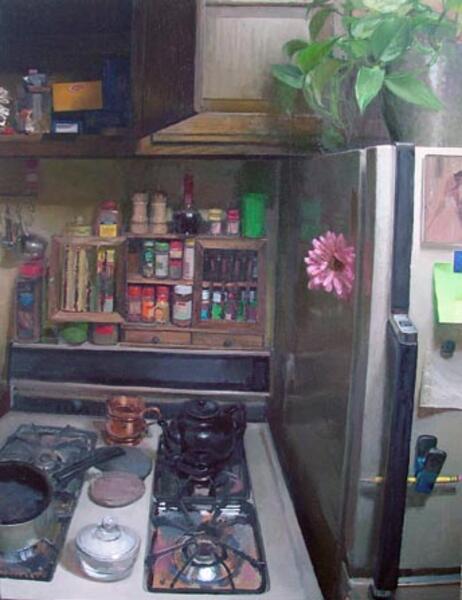 Watched PotOil on Panel 36" x 24" 2006
Watched PotOil on Panel 36" x 24" 2006 -
 plentyoil 47" x 24" 2007
plentyoil 47" x 24" 2007 -
 treasure chestoil 19" x 30 2008
treasure chestoil 19" x 30 2008 -
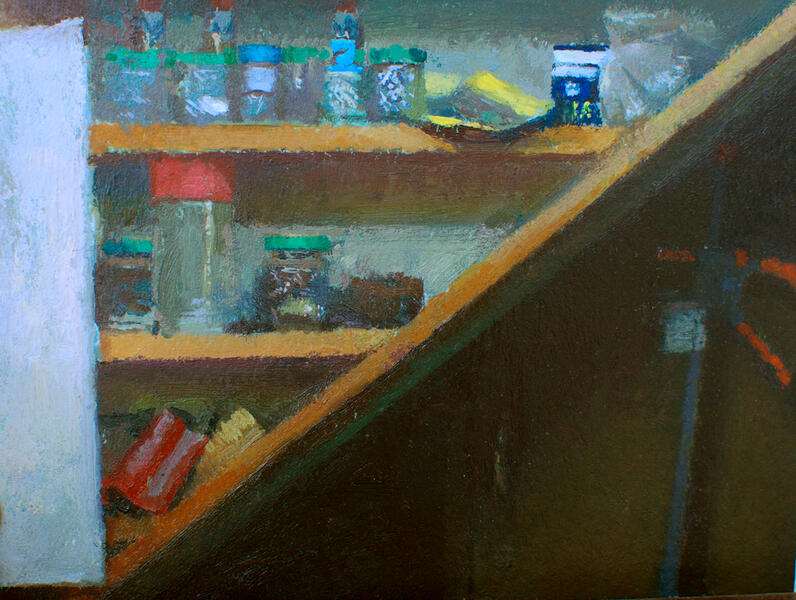 Diagonal (Corner)Oil on museum board 4½” x 6" 2009
Diagonal (Corner)Oil on museum board 4½” x 6" 2009 -
 Ants!oil 16" x 23" 2009
Ants!oil 16" x 23" 2009 -
 Looking Backoil 46" x 36" 2009-2010
Looking Backoil 46" x 36" 2009-2010 -
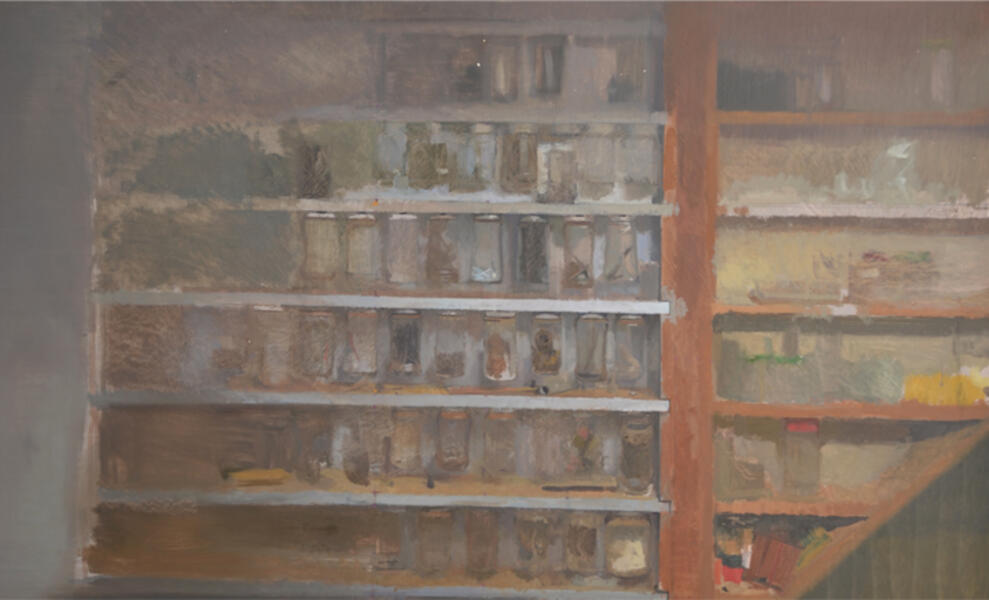 120 vessels2012-currently in progress approx. 32" x 48"
120 vessels2012-currently in progress approx. 32" x 48" -
 Sediment (Blue Pitcher)Oil on Panel 16" x 14 1/2" 2013
Sediment (Blue Pitcher)Oil on Panel 16" x 14 1/2" 2013 -
 Sophisticated MachinesOil on Panel 24" x 24" 2017
Sophisticated MachinesOil on Panel 24" x 24" 2017
Fragments of Fort Howard
Fragments of Fort Howard: Sabbatical project by Matt Klos
“It was like finding the ruins to an ancient city in the jungle,” he said. You wouldn’t believe that in 50 years a place could go back to nature like that.” Baltimore County Executive Frederick L Dewberry, early in 1972
On an unseasonably warm Saturday morning in late winter 2011 I packed a large panel and my paints into my truck and drove 3.7 miles to Fort Howard. I had stumbled upon this 47 acre parcel of federal property situated at the end of the Sparrows Point peninsula during the occasional drive or jog along a surprisingly rural stretch of road. Since the road that leads from my home to Fort Howard leads in the opposite direction of work, shopping, friends, and family it was never on my way but remained on my mind. The majesty and decay of these places left an indelible impression on my mind.
The painting I began that morning in 2011 remains unfinished like nearly a dozen other paintings I’ve begun at the Fort Howard site. Although unfinished artworks are understood as a natural occupational byproduct for artists it may seem strange to some. Why go through all the trouble to begin something and not bring it through to fruition? During my time working at Fort Howard there were a number of reasons why I would abort work on a painting. Occasionally it was due to a significant shift in the season or due to a visual equation that I couldn’t quite sort out. In these cases the paintings are waiting for the seasons to roll around again and for a new solution to be dreamed up. More often, however, my interest in the initial idea, the thesis of the painting, waned over time. In these cases the paintings merely fizzled out and have been sanded down and painted over.
In summer 2013 I embarked on my sabbatical project at Fort Howard by preparing dozens of 2’ and 4’ square painting surfaces. My full time pursuit during the summer and fall of that year was focused on the completion of a series of paintings documenting the structures situated on the Fort Howard grounds. Fort Howard, although largely unoccupied still maintains an outpatient clinic which is open on weekdays and is watched round the clock by security officers to prevent trespassing and vandalism. As a painter and professor of visual art I keep a consistent studio practice and my professional time is split between teaching and personal work. Before my sabbatical it had been nearly seven years since I had been able to pursue studio work for full time. By my estimation a project of this scope would have taken several years without the generous support of the college and the granting of a sabbatical which allowed me to work full time in the studio once again. I am grateful to Dean Dan Symancyk, Vice President Trish Casey-Whiteman (both of whom have recently retired), and Anne Arundel Community College’s Board of Trustees for their efforts in making my sabbatical request a reality.
Leading up to this project I saw two deeply moving exhibitions which helped shape some of my goals. “Richard Diebenkorn: The Ocean Park Series” retrospective at the Corcoran Gallery and “De Kooning: A Retrospective” at MoMA. Both exhibitions confronted the viewer with an impressive sense of scale and various series of works that seemed to be directed by rigid self-imposed rules or restraints. Additionally both artists showed great courage by not “buttoning up” or editing expressive aberrations that fell across the surface of paintings. It seems that these aberrations serve to balance the more ordered and deliberate marks on the paintings’ surfaces netting a gestalt effect that is both emotional and cerebral.
On a sweltering night in August 2011, just two weeks after completing Fort Howard #7, I heard fire engine sirens for the better part of two hours. It wasn’t until two days later when I arrived at Fort Howard and saw the yellow police tape that I realized where the fire trucks had been heading that evening. The white house pictured in Fort Howard, #7 had burned to the ground scorching the giant sycamore tree that grew in front of the house and leaving a pile of rubble and three pillars of brick where the chimneys stood. I set up and began to paint the wreckage but was asked to leave shortly after beginning to work since a police investigation was underway. During the short time I worked that day I could hear the Ospreys scream and sense their agitation as they flew over the burned wreckage which had held their nest. After the fire access to the premises has been strictly limited and for non-veterans a revocable license is needed to visit the Fort Howard site.
While working at Fort Howard I had the pleasure of meeting and hearing from a number of interesting folks. Some belong to families that have lived in the Fort Howard area for generations and some have lived in the military homes within Fort Howard’s grounds. As an example, in early August 2014, an elderly gentleman, who was driving through with his daughter stopped to chat as I was painting the theatre building. He said that when he was a young boy his family didn’t have much money and he would come and sneak into the theatre. He said that the soldiers knew he was there but they didn’t mind. He also mentioned that there was a “colored cook and a white cook” who he would make a point to visit. They were good to him and always gave him a bite to eat. I picked up this story and dozens of others during the making of the project.
Painting onsite and in the elements had its challenges. Lugging large panels, a studio easel, folding table, 3’ palette, and two boxes of paints to the worksites required on average an hour of setup and teardown per session. Some days were uncomfortably hot, interrupted by torrential rain, or painting was abandoned due to the cold and frustration of trying to work in winter gloves. Sometimes when momentum was gained on a particular sunny day painting the clouds would roll in for several days and interrupt my flow. More than once large panels would catch a sudden gust of wind and topple. It was not always possible to find a shady spot in which to stand while also getting a desired view of my subject. As November and December came the days shortened significantly making work on sustained paintings ever more challenging. In spite of all of these things, and indeed, because of these things ideas came to me that certainly wouldn’t have come if I had not been working from life. Working from life, or perceptually painting, requires grafting imagery together and the resultant image is less about one moment in time but rather a collection of many moments in time. The rewards of painting onsite far outweigh the numerous inefficiencies, false starts, discomforts, and frustrations. I had been working on Fort Howard, #6 for about a week in early October. All the while the sky had been an airy and unchanging cerulean blue. Then one morning a patch of magnificent alto cumulonimbus clouds drifted in place and remained for the better part of the day. I spent nearly five hours, an entire painting session, that afternoon reworking the sky which I feel has greatly enhanced the overall effect of the painting. The initial sky was sufficient but it simply didn’t as well. If I hadn’t been there to experience the phenomenon of that day in that particular place I would have missed a critical opportunity.
An account of the Fort Howard facility which was submitted to the National Register of Historic Places in 1979. Dates of historic record and some fascinating facts regarding these structures can be found there.
“It was like finding the ruins to an ancient city in the jungle,” he said. You wouldn’t believe that in 50 years a place could go back to nature like that.” Baltimore County Executive Frederick L Dewberry, early in 1972
On an unseasonably warm Saturday morning in late winter 2011 I packed a large panel and my paints into my truck and drove 3.7 miles to Fort Howard. I had stumbled upon this 47 acre parcel of federal property situated at the end of the Sparrows Point peninsula during the occasional drive or jog along a surprisingly rural stretch of road. Since the road that leads from my home to Fort Howard leads in the opposite direction of work, shopping, friends, and family it was never on my way but remained on my mind. The majesty and decay of these places left an indelible impression on my mind.
The painting I began that morning in 2011 remains unfinished like nearly a dozen other paintings I’ve begun at the Fort Howard site. Although unfinished artworks are understood as a natural occupational byproduct for artists it may seem strange to some. Why go through all the trouble to begin something and not bring it through to fruition? During my time working at Fort Howard there were a number of reasons why I would abort work on a painting. Occasionally it was due to a significant shift in the season or due to a visual equation that I couldn’t quite sort out. In these cases the paintings are waiting for the seasons to roll around again and for a new solution to be dreamed up. More often, however, my interest in the initial idea, the thesis of the painting, waned over time. In these cases the paintings merely fizzled out and have been sanded down and painted over.
In summer 2013 I embarked on my sabbatical project at Fort Howard by preparing dozens of 2’ and 4’ square painting surfaces. My full time pursuit during the summer and fall of that year was focused on the completion of a series of paintings documenting the structures situated on the Fort Howard grounds. Fort Howard, although largely unoccupied still maintains an outpatient clinic which is open on weekdays and is watched round the clock by security officers to prevent trespassing and vandalism. As a painter and professor of visual art I keep a consistent studio practice and my professional time is split between teaching and personal work. Before my sabbatical it had been nearly seven years since I had been able to pursue studio work for full time. By my estimation a project of this scope would have taken several years without the generous support of the college and the granting of a sabbatical which allowed me to work full time in the studio once again. I am grateful to Dean Dan Symancyk, Vice President Trish Casey-Whiteman (both of whom have recently retired), and Anne Arundel Community College’s Board of Trustees for their efforts in making my sabbatical request a reality.
Leading up to this project I saw two deeply moving exhibitions which helped shape some of my goals. “Richard Diebenkorn: The Ocean Park Series” retrospective at the Corcoran Gallery and “De Kooning: A Retrospective” at MoMA. Both exhibitions confronted the viewer with an impressive sense of scale and various series of works that seemed to be directed by rigid self-imposed rules or restraints. Additionally both artists showed great courage by not “buttoning up” or editing expressive aberrations that fell across the surface of paintings. It seems that these aberrations serve to balance the more ordered and deliberate marks on the paintings’ surfaces netting a gestalt effect that is both emotional and cerebral.
On a sweltering night in August 2011, just two weeks after completing Fort Howard #7, I heard fire engine sirens for the better part of two hours. It wasn’t until two days later when I arrived at Fort Howard and saw the yellow police tape that I realized where the fire trucks had been heading that evening. The white house pictured in Fort Howard, #7 had burned to the ground scorching the giant sycamore tree that grew in front of the house and leaving a pile of rubble and three pillars of brick where the chimneys stood. I set up and began to paint the wreckage but was asked to leave shortly after beginning to work since a police investigation was underway. During the short time I worked that day I could hear the Ospreys scream and sense their agitation as they flew over the burned wreckage which had held their nest. After the fire access to the premises has been strictly limited and for non-veterans a revocable license is needed to visit the Fort Howard site.
While working at Fort Howard I had the pleasure of meeting and hearing from a number of interesting folks. Some belong to families that have lived in the Fort Howard area for generations and some have lived in the military homes within Fort Howard’s grounds. As an example, in early August 2014, an elderly gentleman, who was driving through with his daughter stopped to chat as I was painting the theatre building. He said that when he was a young boy his family didn’t have much money and he would come and sneak into the theatre. He said that the soldiers knew he was there but they didn’t mind. He also mentioned that there was a “colored cook and a white cook” who he would make a point to visit. They were good to him and always gave him a bite to eat. I picked up this story and dozens of others during the making of the project.
Painting onsite and in the elements had its challenges. Lugging large panels, a studio easel, folding table, 3’ palette, and two boxes of paints to the worksites required on average an hour of setup and teardown per session. Some days were uncomfortably hot, interrupted by torrential rain, or painting was abandoned due to the cold and frustration of trying to work in winter gloves. Sometimes when momentum was gained on a particular sunny day painting the clouds would roll in for several days and interrupt my flow. More than once large panels would catch a sudden gust of wind and topple. It was not always possible to find a shady spot in which to stand while also getting a desired view of my subject. As November and December came the days shortened significantly making work on sustained paintings ever more challenging. In spite of all of these things, and indeed, because of these things ideas came to me that certainly wouldn’t have come if I had not been working from life. Working from life, or perceptually painting, requires grafting imagery together and the resultant image is less about one moment in time but rather a collection of many moments in time. The rewards of painting onsite far outweigh the numerous inefficiencies, false starts, discomforts, and frustrations. I had been working on Fort Howard, #6 for about a week in early October. All the while the sky had been an airy and unchanging cerulean blue. Then one morning a patch of magnificent alto cumulonimbus clouds drifted in place and remained for the better part of the day. I spent nearly five hours, an entire painting session, that afternoon reworking the sky which I feel has greatly enhanced the overall effect of the painting. The initial sky was sufficient but it simply didn’t as well. If I hadn’t been there to experience the phenomenon of that day in that particular place I would have missed a critical opportunity.
An account of the Fort Howard facility which was submitted to the National Register of Historic Places in 1979. Dates of historic record and some fascinating facts regarding these structures can be found there.
Abstractions
These abstract paintings are allaprima works made in the studio. Work sessions for these paintings range from 20 min. - 3 hours. The paintings are a way for me to explore differing color sets or as an opportunity to continue making when the "window" of longer studio session paintings is hard to find. The practice of making these paintings is cathartic and the subconcious state of flow while painting them often poses answers to questions in other ongoing studio paintings.
First Fort Howard Paintings
There is a largely abandoned veterans facility (currently under federal control) located 3.7 miles from my studio. I started going there in 2012 to paint when I was at a standstill with one of my interior paintings. The structures embody a quiet grandeur and are in various states of decay. Three of the structures have burned to the ground since beginning my work on the site. Although I have not been there to work from live in recent years I continue to work from the paintings I made on site over the course of four years. See my "Fort Howard Project" for more information.
-
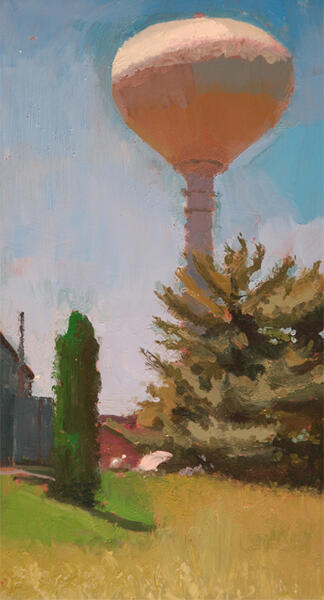 Water TowerThis was on of the first oil paintings I did at Fort Howard. A small one... 7" x 4.5"
Water TowerThis was on of the first oil paintings I did at Fort Howard. A small one... 7" x 4.5" -
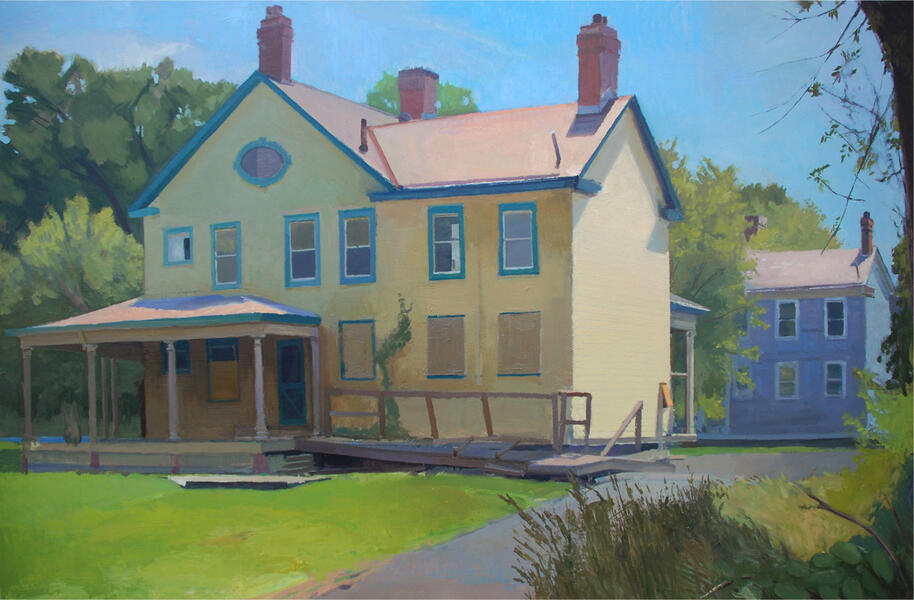 #14Oil on Panel 23.5 x 37.5 To my left (and not pictured here) is a barracks bldg. The house in front of me is the first in a row of houses where officers lived.
#14Oil on Panel 23.5 x 37.5 To my left (and not pictured here) is a barracks bldg. The house in front of me is the first in a row of houses where officers lived. -
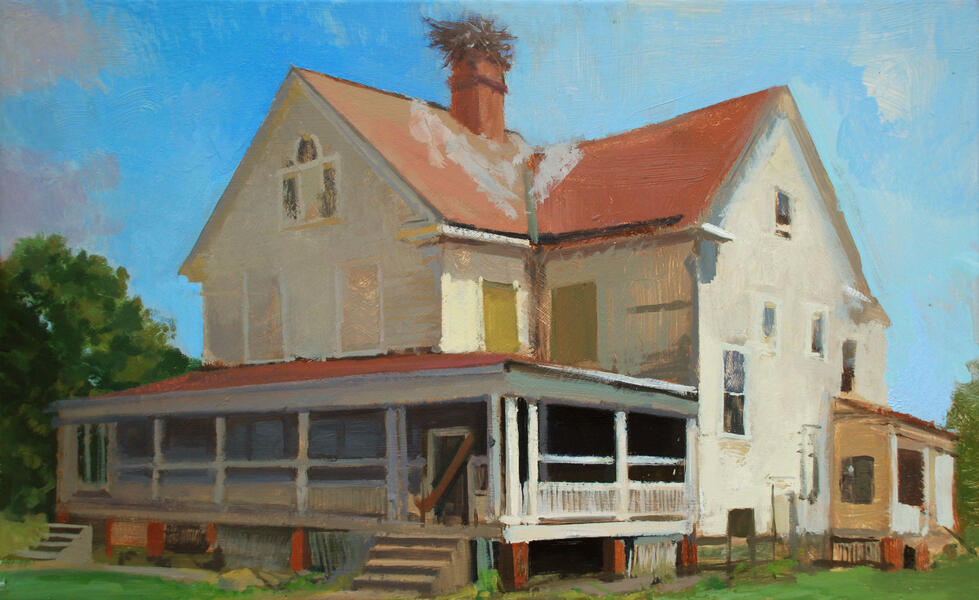 #7One of my favorite houses out here. Unfortunately, this burned to the ground last August (2012). I still remember hearing multiple fire trucks the night this burned. It was eerie to see only the three chimneys standing when I want back to the site several days later.
#7One of my favorite houses out here. Unfortunately, this burned to the ground last August (2012). I still remember hearing multiple fire trucks the night this burned. It was eerie to see only the three chimneys standing when I want back to the site several days later. -
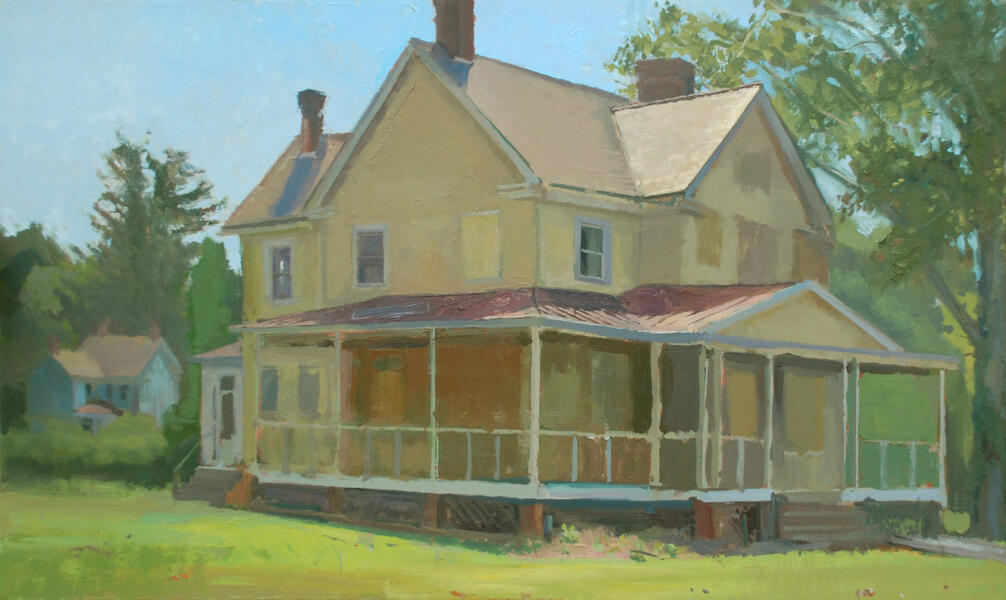 #6Oil on Panel 17" x 27.5" This is the first of the military houses that I painted. These were used as officer lodgings or lodgings for the medical doctors at the North Point Fort Howard Veteran's Facility.
#6Oil on Panel 17" x 27.5" This is the first of the military houses that I painted. These were used as officer lodgings or lodgings for the medical doctors at the North Point Fort Howard Veteran's Facility.

